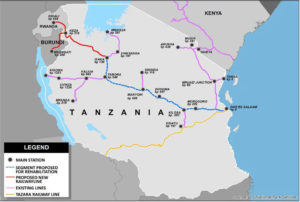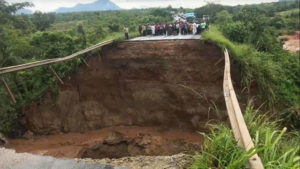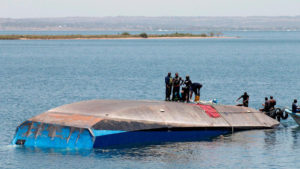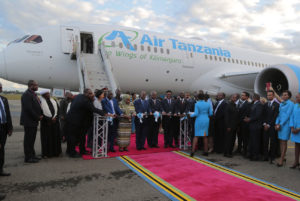by Ben Taylor
Dar Airport Terminal III open
President John Pombe Magufuli opened the Terminal III building at the Julius Nyerere International Airport on August 1, 2019. The new terminal has the capacity to handle 24 large planes concurrently, and six million passengers annually.
Together with the other two terminals, the entire airport will now be able to handle more than 8 million passengers each year. This represents a significant increase on the airport’s busiest year to date: 2016, when 2.5 million passengers passed through. It is expected that Terminal III will handle international flights, while Terminal II will in future only operate domestic flights. The old international terminal is now due for refurbishment and technical upgrading.
The construction of the new facility cost the government a reported TSh 705 billion (US$ 282m). Of this amount, the Tanzanian government paid 15% in cash, with the balance provided in the form of loans from a range of lenders including HSBC bank. “Terminal three has been built using taxpayers money. As it stands, they need to feel the benefit of their money,” noted the President. He therefore directed the Works, Transport and Communication Ministry to ensure that all business at the new premises should be Tanzanian-owned.
Construction of the new terminal building, by Dutch contractors BAM Group, began in 2014. It had initially been due to be completed in 2016, but this was delayed, reportedly due to shortage of funds and a dispute over VAT payments. President Magufuli ordered a probe into the airport project in February 2018 after project costs and construction schedules were derailed.
Terminal I was originally constructed in 1956 by the colonial government, with capacity of handling 500,000 passengers a year. Terminal II, with capacity of handling 1.5 million passengers, opened in 1984. (The Citizen, The Guardian)
Hello Mumbai, London to follow soon?
The inauguration of Terminal III at JNIA came two weeks after the relaunch of long-haul flights to Mumbai, India by the national carrier Air Tanzania. A month earlier, the national carrier launched a direct flight from Dar es Salaam to Johannesburg in South Africa. This brings to seven ATCL’s number of international routes.
Passengers on the inaugural flight included the Minister for Works, Transport and Communications, Mr Isaak Kamwelwe, senior government officials, ATCL staff and journalists.
Mr Kamwelwe expressed optimism that the new route would help in cutting the time spent by passengers who had to connect through Nairobi, Dubai and South Africa. He added that the Mumbai route is of great importance in cementing relationships between Tanzania and India, noting that it would spur the growth of tourism and trade between the two countries. “India has high potential as a tourists source market, and we must take advantage of this by ensuring that we maximally utilize the available opportunities,” the minister said.
The Mumbai route – to be operated three times a week – heralds the airline’s foray into the Asian market. Other planned routes are Bangkok, Thailand, and the Chinese city of Guangzhou.
Air Tanzania spokesperson Josephat Kagirwa said they are also planning flights to London, to Lagos in Nigeria and Accra, Ghana. In addition, a route to Nairobi, Kenya is anticipated.
Significant moves towards establishing the London route have also been completed. The airline has secured three landing slots per week for London’s Gatwick Airport. It is expected that flights will connect both Dar es Salaam and Kilimanjaro Airports with Gatwick on Wednesday, Friday and Sunday each week.
Before this route can begin operations, ATCL need to secure European Union safety standards certification. If Britain leaves the EU later this year as planned, this will require two signatory bodies to approve instead of one: a double headache for the airline, which only regularised its membership with the International Air Transport Association (IATA) recently, by paying back owed membership fees. However, ATCL has already completed the IATA Operational Safety Audit (IOSA).
Currently, there is no direct route from London to Tanzania. British Airways stopped operating the route after four decades in 2013, explaining that it was unable to do so at a profit.
Bagamoyo port development stalled
Talks on a proposed $10 billion development of a port at Bagamoyo have stalled. According to Tanzania Ports Authority (TPA) director general Deusdedit Kakoko, this is because investors’ conditions were likely to deny Tanzania maximum benefit from the project. “The conditions include investors’ demand that they be allowed to set charges for cargo passing through the port. They also want tax exemption on various goods in addition to being compensated for any losses incurred during implementation of the project,” he told The Citizen newspaper in early May.
An initial agreement on the project was signed in 2013 during a ceremony witnessed by President Jakaya Kikwete and Chinese President Xi Jinping. The project was to have been executed by China and Oman’s State General Reserve Fund (SGRF).
In November 2017, SGRF announced that the project would entail the construction in phases of a maritime port built to international standards. The first phase was planned to include the construction of four berths, two of which were to have been set aside for containers, one for multiple uses and another for support services. However, these plans now seem to be in doubt.
According to Mr Kakoko, it was odd that the developers sought tax exemptions on the grounds there was insufficient cargo in the country. “If the country has insufficient cargo, why do they seriously consider Tanzania for investment in railways and ports? The condition requiring the government to compensate the companies in case of losses is the worst. Who knows that they will incur losses? This demand can render the country bankrupt,” he said.
According to him, the doors for discussions were still wide open, noting that the interests of Tanzania will have to take priority. “We are waiting for them. We will be ready for equal participation provided they relax their conditions. They should just bring in the money and be ready to share it with the country, but they should forget about getting 100 per cent preferential treatment,” said Mr Kakoko.
A month later, the stakes were raised further when President Magufuli weighed in on a related matter. The President expressed his strong opposition to the proposed Bagamoyo Special Economic Zone, a 3,000-hectare port and industrial city north of Dar es Salaam.
According to the President, allowing the Bagamoyo initiative to progress would halt expansion of other ports including Tanga and Mtwara, and would entail long tax breaks for investors in the special economic zone. The government has also argued that it would also lose some sovereignty in the management of the project.
The President suggested corruption may have been involved in the government’s payment of billions of shillings as compensation for local residents to create room. “This project has very difficult conditions. They are exploitative and awkward. We can’t allow it,’’ said President Magufuli.
China is in the process of establishing transport and trade infrastructure across Africa, Asia and Europe under the ambitious ‘Belt and Road Initiative’. The Bagamoyo investment was an important part of this global strategy to strengthen the country’s trade and other interests, drawing on the ancient Silk Road trading route.
Opposition leader Zitto Kabwe said President Magufuli was opposed to the project from the beginning. “The conditions he is saying is just diversionary,” said Mr Kabwe, adding that the project would put Tanzania in the world maritime map.
The Speaker of Parliament, Job Ndugai who has publicly expressed support for the Bagamoyo project and challenged the government to roll it out, yesterday backtracked. “We didn’t have information about the stringent conditions that were attached to the project, as was explained by the President,” he said.
Horrific petrol tanker explosion in Morogoro
More than 80 people have been confirmed dead and 50 others serious injured after a fuel tanker exploded into flames at Msamvu in Morogoro town on August 10. Many of the dead were reportedly motor cyclists who were at the scene collecting the spilled fuel and food vendors who conduct their business along the Dar-Morogoro Highway.
The accident occurred about 200 metres from the Msamvu Bus Station in Morogoro town. “The lorry overturned and spilled fuel over 100 metres along the road,’’ said Morogoro Regional Commissioner, Dr Steven Kebwe.
President John Magufuli said he received the news with deep shock. “I have been saddened to learn such a big number of Tanzanians who lost their lives due to the accident. I am extending my condolences to the families of those, who lost their beloved ones and I wish a speedy recovery for those, who were injured in the accident,” he said in a statement.




